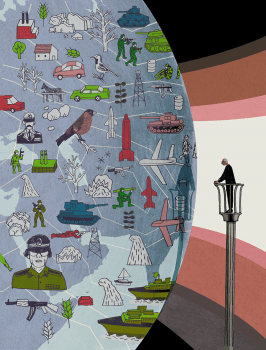David Berreby in Nautilus:
 “Prof” was the English physicist and mathematician Lewis Fry Richardson, for whom doing science came as naturally as breathing. “It was just the way he looked at the world,” recalls his great-nephew, Lord Julian Hunt. “He was always questioning. Everything was an experiment.” Even at the age of 4, recounts his biographer Oliver Ashford in Prophet or Professor? Life and Work of Lewis Fry Richardson, the young Lewis had been prone to empiricism: Told that putting money in the bank would “make it grow,” he’d buried some coins in a bank of dirt. (Results: Negative.) In 1912, the now-grown Richardson had reacted to news of the Titanic’s sinking by setting out in a rowboat with a horn and an umbrella to test how ships might use directed blasts of noise to detect icebergs in fog. (Onlookers might have shaken their heads, but Richardson later won a patent for the fruit of that day’s work.) Nothing—not fellow scientists’ incomprehension, the distractions of teaching, or even an artillery bombardment—could dissuade him when, as he once put it, “a beautiful theory held me in its thrall.”
“Prof” was the English physicist and mathematician Lewis Fry Richardson, for whom doing science came as naturally as breathing. “It was just the way he looked at the world,” recalls his great-nephew, Lord Julian Hunt. “He was always questioning. Everything was an experiment.” Even at the age of 4, recounts his biographer Oliver Ashford in Prophet or Professor? Life and Work of Lewis Fry Richardson, the young Lewis had been prone to empiricism: Told that putting money in the bank would “make it grow,” he’d buried some coins in a bank of dirt. (Results: Negative.) In 1912, the now-grown Richardson had reacted to news of the Titanic’s sinking by setting out in a rowboat with a horn and an umbrella to test how ships might use directed blasts of noise to detect icebergs in fog. (Onlookers might have shaken their heads, but Richardson later won a patent for the fruit of that day’s work.) Nothing—not fellow scientists’ incomprehension, the distractions of teaching, or even an artillery bombardment—could dissuade him when, as he once put it, “a beautiful theory held me in its thrall.”
…Richardson’s finite-difference work had been too novel and unfamiliar to win him a research post at a major university. But in 1913, it helped get him a plum job: directing a research laboratory for Britain’s Meteorological Office, which hoped Richardson would bring both rigorous thinking and practical lab skills to the search for accurate weather forecasts. Here, with a good salary, a house to himself, and a lab far from any distractions, he would have ample time for research. The following year, however, the Great War arrived. At age 32, with his important research ongoing, Richardson could have kept to his agreeable job. Yet even as his principles would not permit him to serve in the military, he still felt he should take part in the war. “In August 1914,” he later wrote, “I was torn between an intense curiosity to see war at close quarters, an intense objection to killing people, both mixed with ideas of public duty, and doubt as to whether I could endure danger.’’ Rebuffed when he requested a leave of absence to serve in the ambulance corps, in 1916 he simply quit. A few weeks later, he and his slide rule, notes, and instruments were at the front.
And so for the next few years Richardson’s theories of war and weather advanced in and around the combat zone. Over six weeks in 1916, with a bale of hay for his desk, Richardson patiently solved equation after equation for hundreds of variables. His aim was to demonstrate his method of “weather prediction by numerical processes” by creating a real forecast.
More here.
